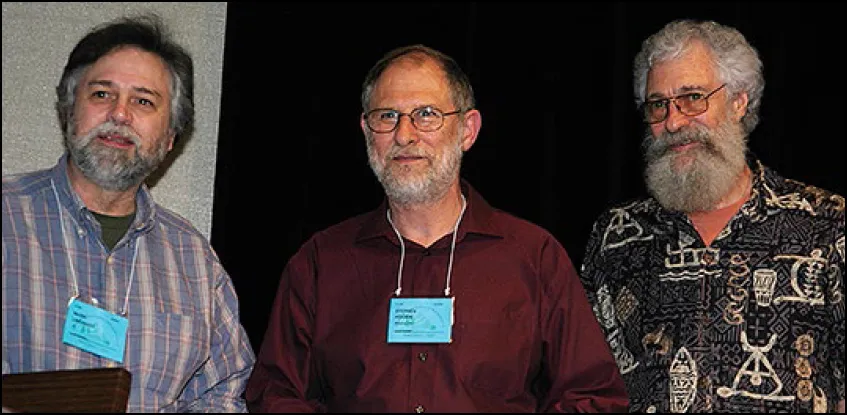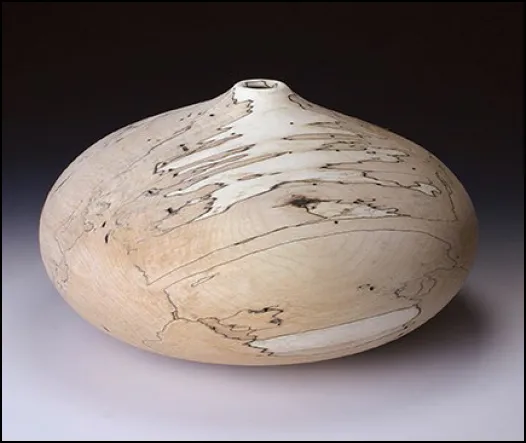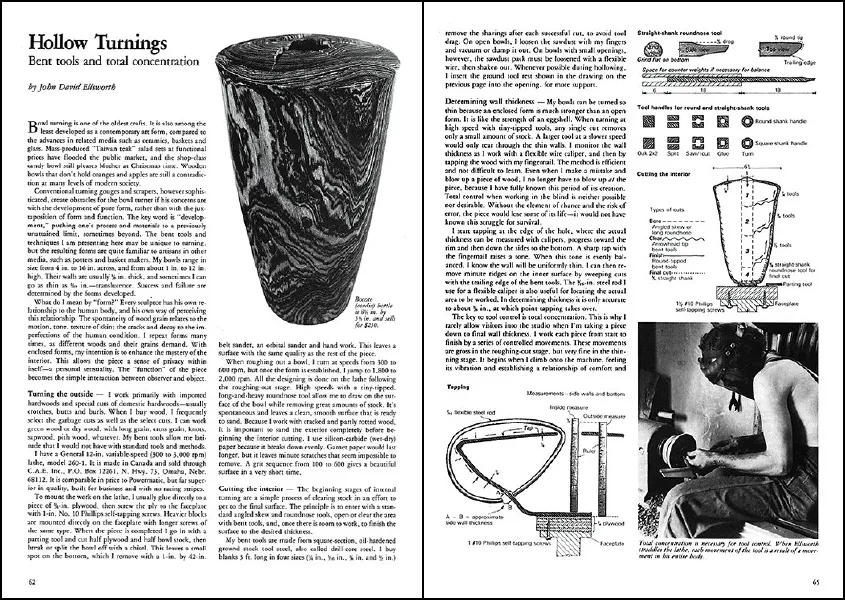![]()
INTRODUCTION
Woodturning in the 21st Century
During the 1960s and ’70s, turned wooden bowls first came to be considered as objects of contemplation rather than simply of function. An art-like market gradually developed among collectors who considered such bowls too beautiful to use. Turners of vision started to ignore tradition, and to make pieces that broke many of the old “rules” of the craft. It was a quiet revolution, but a strangely disconnected one, because many participants had no idea what the others were doing. If anyone read about woodturning, it would have been in books emphasizing the trade values of techniques, not of innovative shapes or aesthetics.
In 1976, the American writer Dona Z. Meilach first documented the work for what it was—the beginning of a new art movement. In her book, Creating Small Wood Objects as Functional Sculpture, Meilach assembled much previously scattered history and put it into a larger context. She was probably the first person to describe turning as “sculptural” and to refer to turners as “artists.” Meilach also introduced people who would shape the new field, such as Melvin Lindquist, Bob Stocksdale and Canada’s Stephen Hogbin (page x). Meilach’s work alerted many artists to the fact that there were others like them, and also inspired many newcomers to join the movement. Meilach continued publishing insightful books on the fields of wood art and general craft, more than 100 in all, until her death in late 2006.
During the 1970s and into the ’80s, the then-new Fine Woodworking magazine published a series of articles that reached an enormous audience around the world and changed the future of turning forever. The series included stories on turning delicate bowls of exotic timber by Bob Stocksdale; heavily spalted wood, previously unheard of, by Mark Lindquist; green turning, a technique practiced by turners for hundreds of years, by Alan Stirt; inlaid wood with hi-tech finishes by Giles Gilson, and, most significant of all, a 1979 article by David Ellsworth (page xi) on hollow turning. Ellsworth laid down his challenge to the turning world: “Bowl turning is one of the oldest crafts. It is also among the least developed as a contemporary art form.” Ellsworth was good at explaining the technical aspects of his work—lathe specifications, speed, tools—but he also introduced language and a philosophy that had never before been heard in relation to turning: “The concentration involves all senses equally, and the center of focus is transferred to the tip of the tool.” It was heady stuff, just right for the times, and it hit the mark in a culture ready for rule-breakers.
In 1980, Dale Nish of Provo, Utah, published the milestone book Artistic Woodturning. Nish showed foresight when he put the word artistic on the cover and he introduced ideas that profoundly influenced turners around the world. Nish spoke of paying “tribute to nature’s designs,” and of making the most of faults and damage in wood. Nish was one of the first to chronicle the changing ways turners were using wood, and their new approaches to displaying its beauty.
Ron Fleming, Yama Yuri, 2006. Basswood, acrylics; 36″ high x 17″ diameter. Fleming created the turned vase as a vehicle for the painted lilies, which are life-size. He says, “I had to reinvent the air-brush process to be able to apply the frisket on a curved surface. There’s more than 400 hours in it.” For more of Fleming’s work, see page 31.
Photo courtesy the artist
Nish followed up in 1985 with Master Woodturners, featuring the work of nine artists who, if they were not already, were transformed into turning icons: the Americans David Ellsworth, Mark Lindquist, Ed Moulthrop, Rude Osolnik, Al Stirt, and Jack Straka, along with England’s Ray Key and Australia’s Richard Raffan. The inclusion of the latter two was an early indication the new field was becoming an international phenomenon. In 1985, The Taunton Press published Turning Wood, the first of Raffan’s widely sold series of how-to books and videos, which many artists today cite as a valuable part of their education.
Other turners who were repeatedly acknowledged as mentors and exemplars in interviews for this book include David Pye, Del Stubbs, Bob Stocksdale, Michael Hosaluk, Al Stirt, John Jordan, Jean-Francois Escoulen, and Mike Scott. It is impossible to give credit to all of those who deserve it, yet it is worthwhile mentioning the reputations of some woodturners have been compounded by repetition during the last thirty years, while many equally deserving names have been passed over. Like any field of endeavor, creative woodturning has a history filled with anonymous and forgotten contributors.
Stephen Hogbin was born and educated in England, then immigrated to Canada in 1968, to teach design. In 1974, he astonished the craft world with an audacious exhibition timed to coincide with a World Craft Congress meeting being held in Toronto that year. Hogbin was, perhaps more than any other person, responsible for upsetting the tyranny of the circular form that had dominated the turning world for thousands of years.
Stephen Hogbin’s 1974 Toronto exhibition astounded woodturners and the larger craft world alike. As the woodturning writer and educator Mark Sfirri has said, “Hogbin was 20 years ahead of his time, and now, 30 years later, he is still 20 years ahead of his time.”
Hogbin’s first book, Woodturning: The Purpose of the Object, was published in the mid-1970s and shattered many preconceptions about materials and techniques. As Steven Kennard (page 139) said, “It really opened a door, as this idea was so new to me—that something which primarily makes round objects could be used to produce sculptural pieces that left you wondering how they were created.” Hogbin showed the way for the many artists who would later cut, rejoin, color, combine materials, and bend the rules. Marilyn Campbell (page 133) said, simply, “He showed me turning could be art.”
David Ellsworth, right, presents the American Association of Woodturners lifetime achievement award to Mark Lindquist, left, and Stephen Hogbin, center, at the AAW’s 2007 conference. Photo by John Kelsey.
A New Collector
The new work attracted a new kind of collector, people who not only fell in love with the lure of wood, but also believed the leading woodturners could become the new art stars. It was not to be the case. If the new turning heroes became famous, it was not in the broader art field, but among the legion of aspiring turners with lathes in their garages who sought to create similar work. The amateur artisans formed a new market for tools and hardware, and for a time each new turning idea generated a new line of equipment. From sophisticated hollowing systems to ever-larger lathes, vast numbers of tools were manufactured and sold to the burgeoning amateur market. As a result, a thin and difficult-to-navigate line developed between amateurs who were able to create technically proficient work, largely by imitating or taking classes from their heroes, and those who had a distinctly original aesthetic vision that propelled the field forward.
Very early on, a small group of woodturners emerged as the collectible masters. The group included James Prestini, Bob Stocksdale, Melvin and Mark Lindquist, Rude Osolnik, and Ed Moulthrop. As the field expanded during the 1980s and ’90s, new artists entered the gallery system, among them such innovators as Todd Hoyer, Stoney Lamar, Michael Peterson, Giles Gilson, John Jordan, Mike Scott, and Michelle Holzapfel. The infusion created challenges for new collectors and curators, who had to navigate a scene where accomplished artists exhibited alongside emergent novices. The early success of the true innovators suggested originality was the key to sales, so the new generation began to create ever more unusual and technically complex work. At the same time, some who had already made their mark by creating original work seemed condemned to repeat their ideas incessantly, to satisfy the desire of collectors to own a signature piece.
Ellsworth came to broad notice in 1979 when Fine Woodworking magazine introduced his techniques for hollowing wood through narrow openings to create vessels more like pottery than any woodwork that had gone before. His work overturned all of the deeply held traditions of functionality that had defined turning. Ellsworth himself was profoundly influenced by Native American pottery, and he planted the seeds for the explosion of creative woodturning that was to follow. For the first time, woodturners were seeing themselves as artists.
David Ellsworth astounded the woodworking world with his 1979 magazine account of his hollow-turning techniques, combined with his perspective on where his work fit in the larger craft/art world.
Ellsworth went on to help found the American Association of Woodturners, serving several terms as its president. He continues to produce his astonishing hollow-turned turned vessels at his studio in Quakertown, Pennsylvania, where he also teaches weekend seminars and manufactures his own line of tools for hollow turning.
David Ellsworth, Ovoid Pot #1, spalted sugar maple, 6″ high x 11″ diameter. His pieces combine the fluid lightness and elegant form of pottery with the beautiful figure and texture of wood.
Richard Raffan often is acknowledged ...





